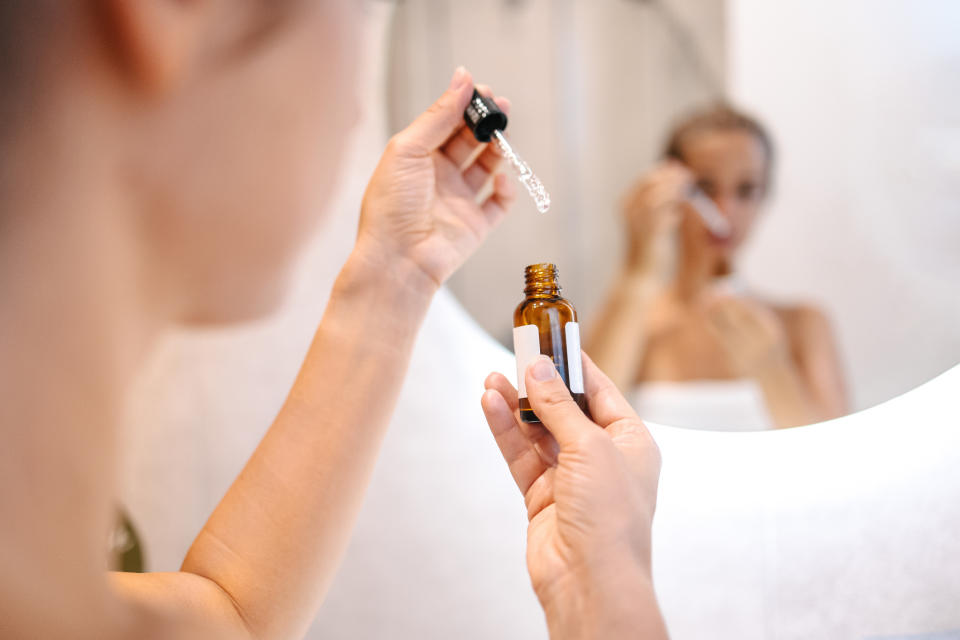Does Oil Gritting Really Remove Blackheads? Skin Pros Weigh In on the Viral Trend
There’s a new method of exfoliation in town, and it sounds a lot rougher than it is. So-called "oil gritting" or "skin gritting" is the process of using an oil-based cleanser to remove makeup and debris from the skin and shrink the appearance of large and clogged pores on areas like the nose, chin and forehead. “It is supposed to be a method of deep cleaning and involves massaging oil into your skin for several minutes once a week,” explains skincare expert Jodi LoGerfo, DNP, APRN, FNP-BC. “Purportedly, the contents of the pores dislodge, expelling sebaceous contents. It is viral on social media right now, but there is no scientific evidence behind it,” she adds.
One benefit being touted: It expels those tiny, dark particles you often see in your pores — without any squeezing or popping. People are doing it on TikTok and claim it really works.
But does it actually work? Before you toss those Biore nose strips, let’s see if this viral method for battling stubborn blackheads has any validity to it.
How does oil gritting work?
Because oils are lipophilic or “fat-loving,” meaning they travel deep into the skin and act as a barrier to keep bad stuff out, the theory behind oil gritting is that it can help to dissolve and loosen the debris, sebum and dead skin cells that get trapped within our pores, especially those pesky sebaceous filaments known as blackheads. As the oil is massaged into the skin (an integral step in oil gritting), these particles become dislodged and are eventually pushed from the pores, appearing as tiny grains or "grits" on the skin's surface.
The problem is oil gritting may not be all it’s cracked up to be. “What you are actually seeing on the skin’s surface after oil gritting are dead skin cells from the act of massaging, not the actual embedded sebaceous filaments,” says Jordan Harper, NP, CEO and founder of beauty brand Barefaced. At the very least, even if you aren’t getting to the "nitty gritty" of what lurks deep inside your pores, you’re still at least getting a decent exfoliation.
Can I use any kind of oil for oil gritting?

In short, no. Not all oils are the same when it comes to skincare. While the internet may say otherwise, dermatologists say that putting a common kitchen oil on your face, like olive or vegetable oil, can actually give you the dreaded clogged, puffed-out pores. “It’s best to use an oil cleanser that’s specially formulated for the face, such as CeraVe Foaming Oil Cleanser or Burt’s Bees Facial Cleansing Oil,” advises Dr. LoGerfo. Another one of our favorites is the La Roche-Posay Lipikar AP+ Gentle Foaming Cleansing Oil.
Oils such as mineral, jojoba, grapeseed, hemp seed, safflower, sunflower and rosehip can also be used. They are packed with antioxidants and high in linoleic acid — a fatty acid used as an emollient in skincare — and have been studied for their beneficial effects on the skin, such as hydrating and plumping and protecting the skin barrier from pollution and UV rays.
“It is important to remember that you can worsen skin conditions like psoriasis, eczema, rosacea or acne if you are using comedogenic oils (i.e., the type that clogs the pores) or rubbing too harshly,” says Dr. LoGerfo. Also, it’s always a safe bet to check the label to ensure you’re not potentially allergic to any of its ingredients before you put anything new on your face.
Related: How to Get Rid of Pimple Redness: Top Dermatologists’ 6 Simple Tips
What are the steps for oil gritting?

If you do decide you want to try it, here are the steps to doing it correctly, according to our experts:
Select your oil: Choose an oil-based cleanser that’s non-comedogenic (i.e., non-irritating) and suitable for your skin type.
Apply the oil cleanser: Begin by applying a small amount of the oil cleanser to your hands and rubbing gently to warm it. Gently massage the oil into dry skin using circular motions, focusing on areas where you have noticed congestion or sebaceous filaments.
Massage thoroughly: Massage the oil into your skin for about 10 minutes to help dissolve makeup and impurities and loosen debris within the pores. If you have more sensitive skin, you may want to massage for only about 2-3 minutes.
Allow time for the oil to work: After massaging it into your skin, allow it to sit for a few minutes. This gives the oil time to penetrate the pores and loosen any trapped debris.
Massage again: After allowing the oil to sit, massage your skin again. You may notice tiny, gritty particles beginning to emerge from your pores.
Rinse thoroughly: Once you've completed the oil cleansing and gritting process, rinse your skin thoroughly with lukewarm water. Use gentle, circular motions to remove all traces of oil and debris from the skin.
Follow up with a second cleanser (optional): Some people prefer to follow with a water-based cleanser to remove any remaining residue from the skin. Choose a gentle cleanser suited to your skin type and rinse thoroughly. Or, you can use a toning pad with alpha hydroxy and beta hydroxy acids like Barefaced Toning Pads, which further help to unclog pores.
Moisturize: After cleansing, finish with your regular skincare routine, including serums, moisturizers and sun protection. Repeat weekly or as needed.
Does oil gritting actually work?
While there’s likely no harm in trying it, is it worth 15 minutes of our time? “Oil gritting could help the skin by sloughing off dead skin cells. It could also potentially help remove makeup and cleanse dirt. All of this could improve the appearance of mature skin,” says Dr. LoGerfo. “However, there are no documented benefits for skin, and again, there is no scientific evidence regarding oil gritting for any skin type,” she says. “In my opinion, oil gritting probably benefits those with acne-prone and oily skin the most because oil attracts oil.”
While there’s no science behind oil gritting specifically, there is research that shows applying or massaging oils into the face can help with inflammation and skin barrier repair.
Are there any other benefits to using facial oils?
Facial oils can be helpful in another trendy skin technique known as ‘oilplaning,’ which is essentially at-home dermaplaning, which gives skin a deep exfoliation and gets rid of peach fuzz. Instead of using the blade on dry skin, you apply oil all over your face first.
“I do love facial oils for the skin in general and especially for shaving your face,” says Harper. “If you are shaving your face on dry skin, stop immediately and start oil-planing instead,” urges Harper. You can also layer an oil as the very last step in your skincare routine to lock in hydration. “This is great for more mature skin types that produce less hyaluronic acid in the skin and who are more prone to dryness,” she explains.
Related: Why Women Over 50 Are Choosing ‘Dry Oils’ to Hydrate and Beautify Their Skin + 3 Top Picks Under $20
For more viral skincare techniques, click through these stories:
Glass Skin Is the Viral Beauty Trend That’ll Leave You Glowing — Here’s How to Get It
Why Everyone Is Buzzing About Matcha Benefits for Skin + How It Can Help Women Over 40
Skin Flooding: The Viral Trend Dermatologists Swear By + How to Get the Best Results

